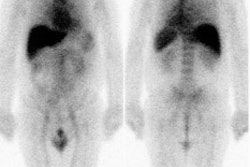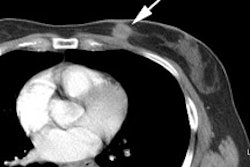SAN FRANCISCO - FDG-PET and FMISO-PET scans offer valuable information on hypoxia, a condition that can hamper the treatment of head and neck tumors, according to researchers from the University of Washington and the VA Puget Sound Health Care System in Seattle.
Dr. Joseph Rajendran, from the university’s division of nuclear medicine, presented his team’s work Tuesday at the American Association for Cancer Research meeting. Their goal was to evaluate the role of metabolic and hypoxia imaging with PET in characterizing head and neck tumors. Hypoxia occurs when the oxygen supply to a tissue is reduced despite adequate perfusion.
"Hypoxia has been a problem for radiation oncologists for some time. Hypoxia makes the cancer cells very aggressive. It also increases metastatic potential. But the main problem is that it makes cells resistant to radiation therapy and chemotherapy," Rajendran told AuntMinnie.com.
For this study, 18FDG-PET was used because of its ability to evaluate tumor metabolism and assess tumor viability. The uptake of 18FMISO (fluoromisonidazole) in a second PET exam indicated the amount of tissue hypoxia. All imaging was done on an Advance Nx/i PET system (GE Medical Systems, Waukesha, WI).
Twenty-four patients with head and neck cancer (23 with squamous cell carcinoma; 1 with adenocarcinoma of the parotid gland) underwent whole-body PET scans between September 2000 and October 2001. Of the 15 patients who had 18FMISO-PET exams, 12 also had 18FDG-PET scans. Imaging exams were done one day apart, Rajendran said. The standardized uptake value (SUV) of FDG was measured, while the percentage of pixels in the tumor above normal tissue (PANT) was used to quantify the degree of hypoxia.
Based on the results, the mean 18FDG SUV was 10.3. Six patients (40%) showed evidence of significant tumor hypoxia with a mean of 20.2% above normal tissue uptake. There was concordance between 18FDG SUV and 18FMISO-PET in 42% of the patients.
"Routine pre-therapy evaluation for hypoxia using 18FMISO in patients with head and neck cancer, along with 18FDG metabolic imaging, is feasible and should help in selecting optimum therapy, as well as help in treatment planning," the group concluded.
Rajendran said further research needs to be done with PET and hypoxia, including correlating nuclear medicine scan results with other biological markers, such as gene arrays, before this protocol is introduced into clinical practice at his institution.
By Shalmali PalAuntMinnie.com staff writer
April 10, 2002
Related Reading
Age and marital status affect morbidity following cancer treatment, November 31, 2001
Ref5 Head and Neck PET, August 29, 2001
CT beats MRI overall for staging head and neck cancer, March 3, 2001
Accelerated radiation improves tumor control in head and neck cancer, October 26, 2000
Copyright © 2002 AuntMinnie.com




















